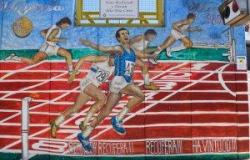There has been much talk, in recent months, about the opportunity to endorse the presence of the Israeli Pavilion at the 67th Venice Art Exhibition scheduled from 24 April to 24 November. The appeal promoted by the international alliance of artists and cultural workers dates back to last February Art Not Genocide Alliance (ANGA), formed for the occasion, to ask for the exclusion of the country and therefore not “legitimize its genocidal policies in Gaza”. There were 12,500 international signatories and they include artists who will participate in this year’s edition but also artists from previous editions.
“As the art world prepares to visit the nation-state diorama at the Gardens,” the letter reads, “we affirm that it is unacceptable to host a state engaged in ongoing atrocities against Palestinians in Gaza.” According to the ANGA, “Every official representation of Israel on the international cultural scene is an encouragement of his policies and the genocide in Gaza”. “The Biennale”, add the artists, “is giving voice to a State that has been guilty of genocide and apartheid”. Also in February, many people, including singers, professionals and potential spectators, had filled social media with the hashtags BanIsraelFromEsc and BoycottEurovision , saying that Israel should have been excluded from Eurovision 2024 as happened to Russia in 2022, following the invasion of Ukraine. Similar protests are taking place in various Italian universities, with several appeal letters to ministers and rectors urging the interruption of relations with Israeli universities. In short, culture and art are not, and cannot, by their very nature be neutral with respect to a dramatic geopolitical situation. But the parties, i.e. those who call for the boycott and those who support the right of Israeli researchers and artists not to be assimilated to those who govern them, almost never manage to dialogue.
The polarization on the Israeli-Palestinian issue is perhaps the most extreme there is. But there are those who try, without gathering much consensus because it seems to displease everyone, to find some sort of mediation. She had it up Artribune Fiammetta Martegani, Tel Aviv correspondent since 2009 and curator of the Eretz Israel Museum since 2015. Martegani, regarding the appeal against the Israeli pavilion at the Biennale, had written that “it would have been much more significant and productive to invite collaboration between Israeli and Palestinian artists, as they did during the Berlin Festival where it has just been the documentary was awarded No Other Landdirected by a team of Israeli and Palestinian directors: Yuval Abraham, Basel Adra, Hamdan Ballal, Rachel Szor”. Then he added: “Boycott the Israeli Pavilion of the Biennale, therefore, means – as in the case of the university boycott – boycotting all those artists (or professors) who have always represented the most critical voice of Israel. They are the ones who marched along Kaplan Street for 39 consecutive Saturdays, opposing the prime minister’s bad government Benjamin Netanyahu”. However, the issue was closed by those directly involved. The artists and curators of the Israeli national pavilion at the Venice Biennale announced their decision not to open until “a ceasefire and hostage release agreement is reached” in the Gaza conflictand they announced it on the preview day of the largest and most important global gathering in the art world.
A sign on the facade of the Israel Pavilion at the Giardini, or public gardens, in Venice, one of the main venues of the Biennale, communicated the team’s decision, while the pavilion itself was guarded by three armed Italian soldiers. At the Gardens, Israeli artist Ruth Patir’s video work Keening was visible through the glass façade of the modernist pavilion. But the rest of the exhibition, installed inside, on the theme of fertility, entitled (M)otherland“awaits the moment when hearts will be able to open up to art again”, as the organizers wrote.
Patir said: “As an artist and educator, I strongly oppose the cultural boycott, but today I experience considerable difficulty in presenting a project that speaks to the vulnerability of life in a moment of unfathomable contempt for it.” Curators Mira Lapidot and Tamar Margalit added: “Six months have passed since the brutal attack on Israel on October 7 and the start of the terrible war raging in Gaza. There is no end in sight, only the promise of more pain, loss and devastation. The exhibition is ready and the pavilion awaits its inauguration. Art can wait, but women, children and people living in hell cannot”. The organizers add: “The decision of the artist and the curators is not to cancel themselves or even the exhibition; rather, they choose to take a stand in solidarity with the families of the hostages and with the large Israeli community that is demanding change”.
Palestinian artists are represented at the Venice Biennale in the centrally curated main exhibition, as well as through a “collateral event,” an affiliated exhibition titled South West Bank. The initiative of the theme of the Israeli pavilion did not convince them, on the contrary. One of them, Adam Broomberg, said immediately after the Israeli announcement: “Just a big chess move. The building should remain closed until the end of the occupation and apartheid and until all Palestinians are given granted the full right of return”. The Art Not Genocide Alliance also wrote in a statement on Instagram on Tuesday, April 16, that Patir’s protest is an empty and opportunistic gesture “timed for maximum press coverage.” The artist did not respond, and when asked by the New York Times she said that she hopes that the conditions will be met to be able to welcome visitors before the end of the Biennale on November 24th. On a hopeful note, she said “I believe we will make it.”
THE MOST READ ARTICLES ON ELLE.IT

The best spring color trends











